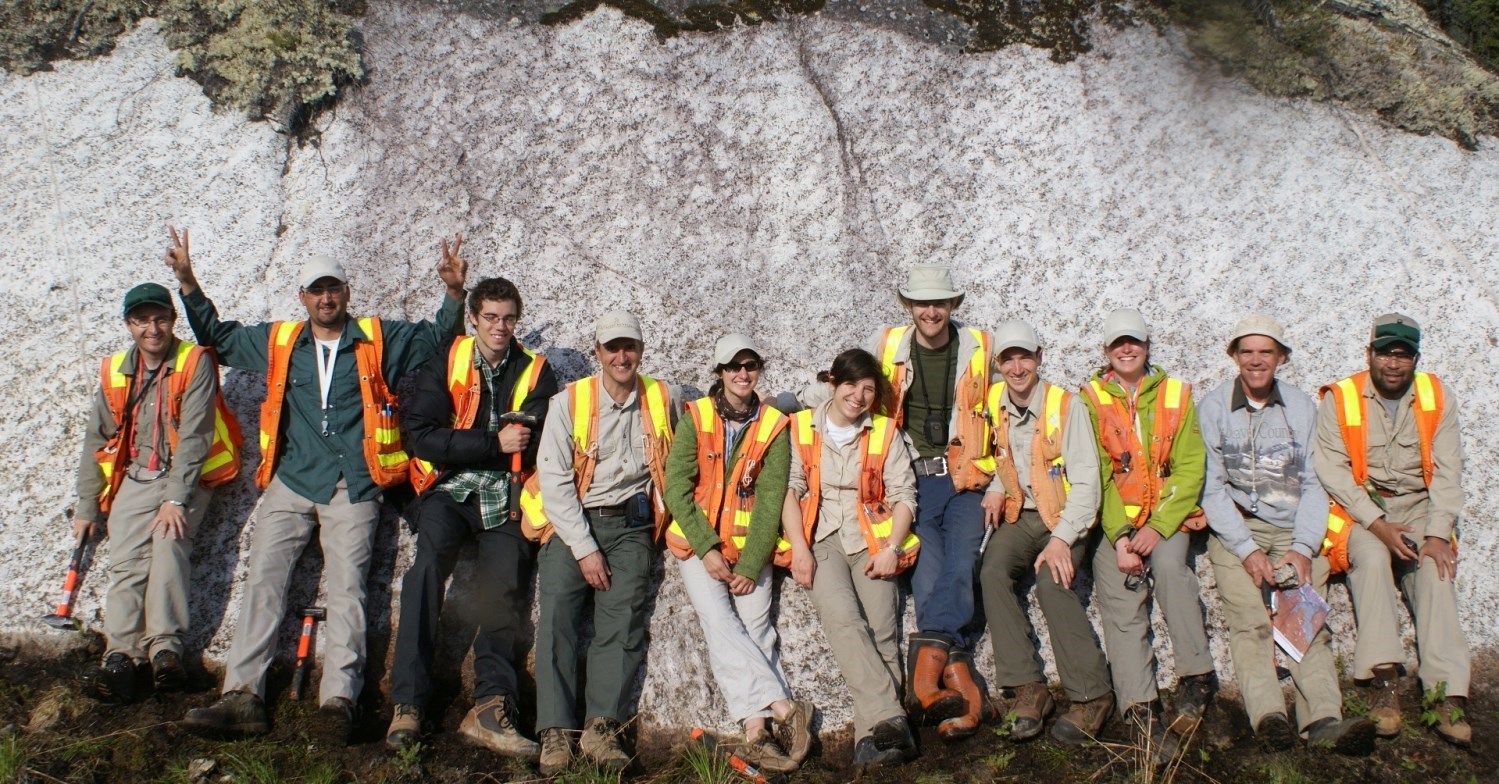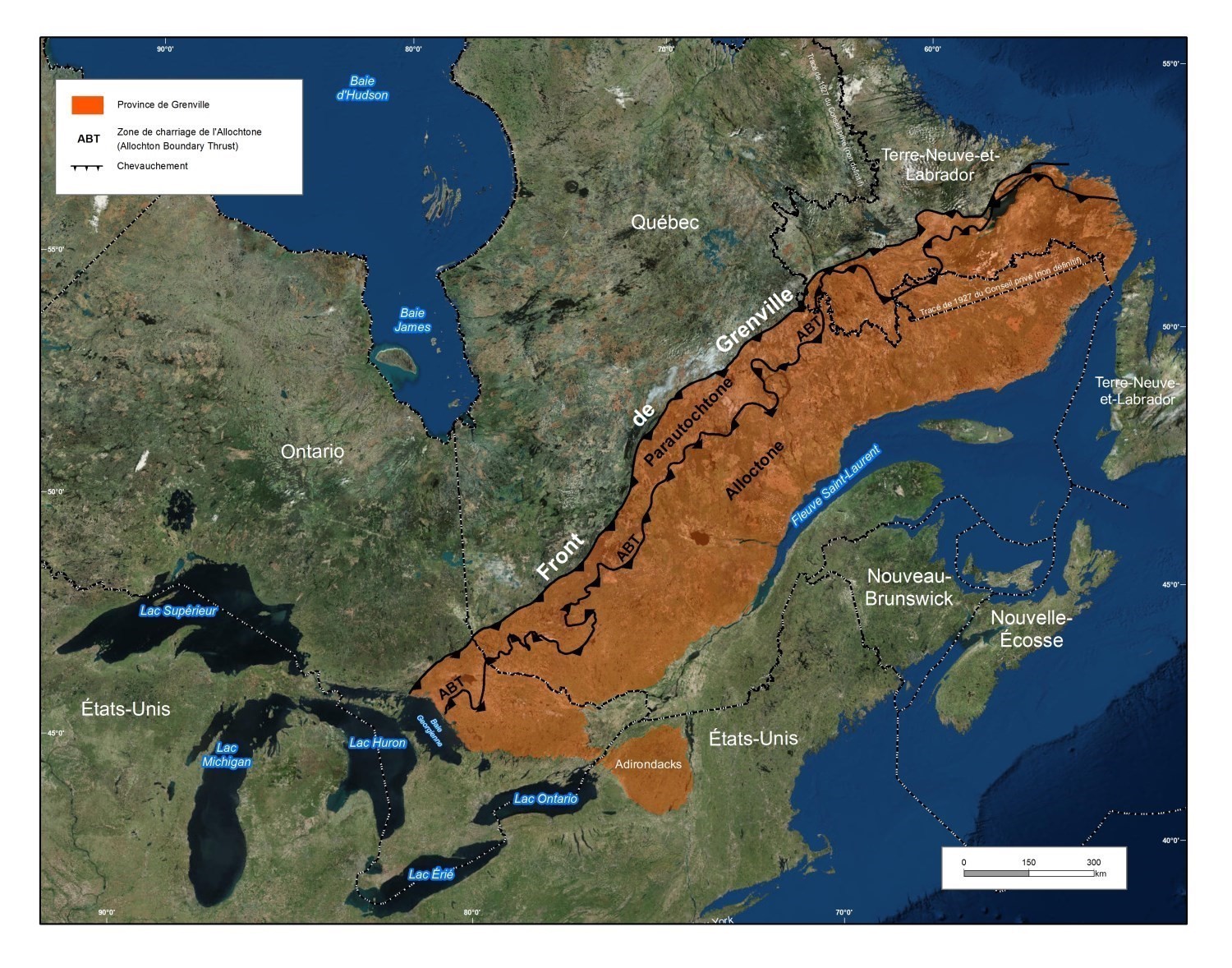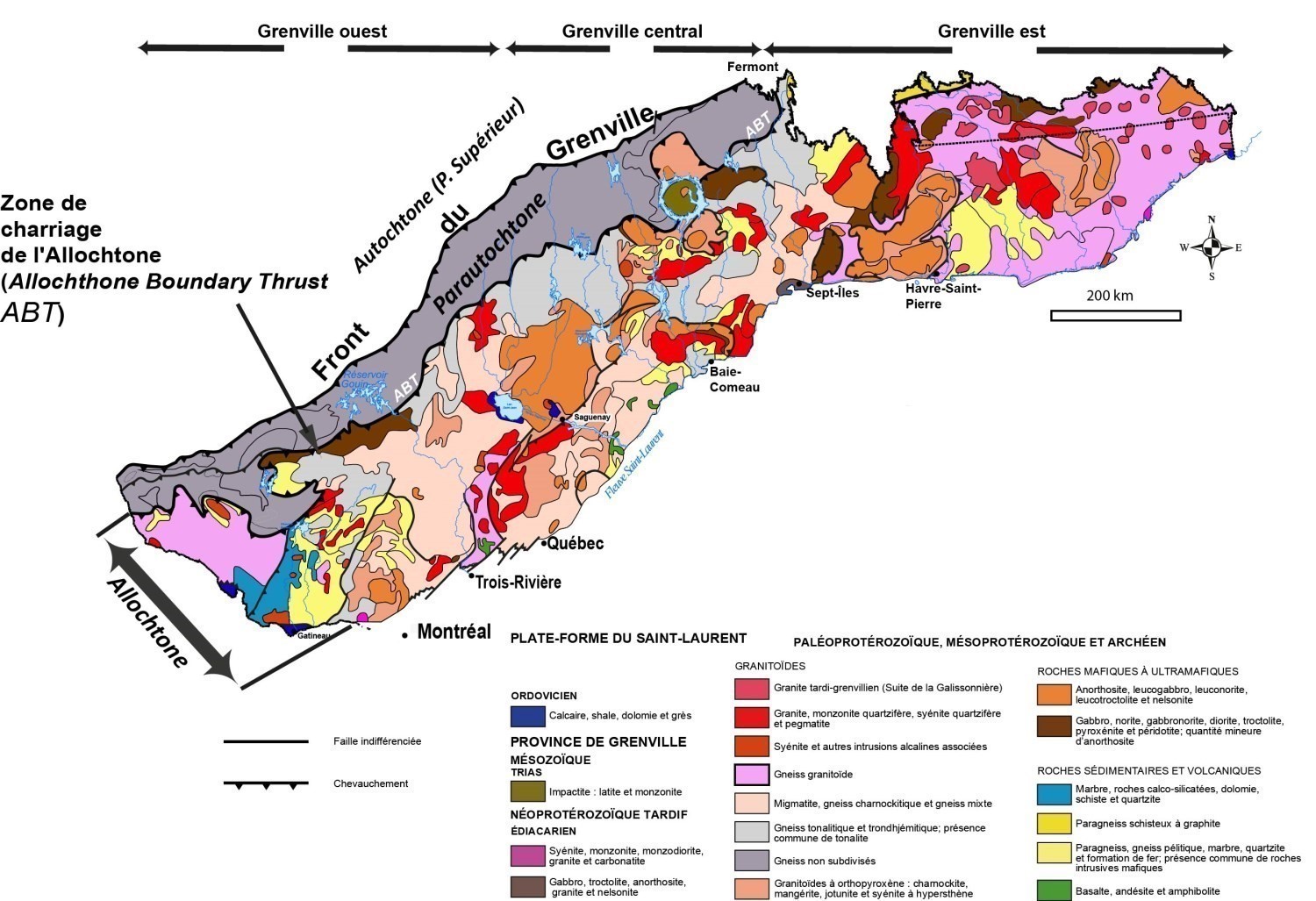
Background
The term “Allochton” was defined based on tectonic, magmatic and metamorphic criteria by Rivers et al. (1989). The latter have subdivided the Grenville Province into three main domains: Parautochton, polyciclic Allochton and monocyclic Allochton. Since it is recognized that metamorphic grades and ages are highly variable throughout the Grenville Province (Rivers et al., 2012), the terms polycyclic and monocyclic are no longer used.
Description
The Allochton consists of all the terrains in the Grenville Province that are south of the Parautochton. In Canada, it extends from the Great Lakes, to the SW, to Labrador, to the NS. In the province of Quebec, it occupies an area of nearly 395,000 km2. Its northern boundary is the Allochton Boundary Thrust (ABT) of Rivers et al. (1989), and is limited to the south by Paleozoic rocks of the St. Lawrence Platform and Appalachians. In addition, it overthrusts rocks of the Parautochton.
Geology
The Allochton is composed of Mesoprotetozoic to Neoproterozoic rocks (1.6-0.985 Ga). The juxtaposition of the Allochton on the Parautochton occurred during the Grenvillian orogenic cycle (1.09-0.985 Ga; Rivers et al., 1989). Rocks of the Allochton were metamorphosed to the upper amphibolite and granulite facies during the Ottawa phase (1.09-1.02 Ga; Rivers et al., 2012) of the Grenville Orogenesis. A few areas have reached the eclogite facies, including rocks of the Manicouagan imbricate zone in central Grenville (e.g., Indarès and Dunning, 1997).
In the western part of the Grenville, the Allochton consists mainly of the Mont-Laurier and Morin terrains. The Mont-Laurier Terrain consists of horizons of platform marble, quartzite and pelite, and Mesoproterozoic amphibolite horizons in which gabbro sills and felsic and mafic intrusions have been inserted, including some of ultrapotassic composition. The Morin Terrain is dominated by charnockitic and anorthositic intrusions that cut metasediments and orthogneiss.
In central Grenville, migmatites, quartzo-feldspathic orthogneiss and mangerites predominate. The northern portion of the Allochton population is characterized by an abundance of charnockitic gneiss and amphibolites (Moukhsil and Solgadi, 2018). Several anorthositic intrusions are scattered throughout the Allochton Belt. In the mid-Côte-Nord region, Gobeil et al. (2003) subdivided Allochton rocks into three tectono-stratigraphic domains that are, from west to east, the Lac-à-l’Aigle, Saint-Jean and Natashquan domains. The Lac-à-l’Aigle Domain is composed mainly of gneissic rocks of various composition and origin, metasedimentary rocks, granitoid intrusions, gabbro, gabbronorite and anorthosite. The Saint-Jean Domain consists of a variety of gneissic, sedimentary and igneous rocks, as well as several anorthositic massifs. The Natashquan Domain includes a thick sequence of siliciclastic supracrustal rocks, the Wakeham Group. It is surrounded by metamorphic complexes of orthogneiss containing enclaves of supracrustal rocks, similar to those of the Wakeham Group. The Natashquan Domain also contains felsic plutonic suites and many patially amphibolitized mafic dykes and sills.
The mid-Côte-Nord area is also characterized by events related to the beginning of the Appalachian cycle and opening of the Iapetus Ocean. Grenvillian rocks are cut by a series of mafic or felsic intrusions in the form of diabase dyke swarms or igneous complexes, such as the Sept-Îles (565 ±4 Ma; Higgins and van Breemen, 1998) and Baie des Mountons (568 Ma; Doig and Barton,1968) complexes, and the Rigaud Pluton (564 +10/-8 Ma; Malka et al., 1996).
Finally, the Grenville basement is partially covered by a subhorizontal sequence of Lower Paleozoic sedimentary rocks belonging to the St. Lawrence Platform. There remains a fringe of this sequence in the coastal areas of Havre-Saint-Pierre, the Mingan Archipelago and Lake Saint-Jean, as well as deep in gorges and valleys in the foreshore; remnants also remain around the Manicouagan Reservoir.
References
| Author(s) | Title | Year of Publication | Hyperlink (EXAMINE or Other) |
|---|---|---|---|
| DOIG, R. – BARTON, J.M. Jr. | Ages of carbonatites and other alcaline rocks in Québec. Canadian Journal of Earth Sciences; volume 5, pages 1401-1407. | 1968 | Source |
| GOBEIL, A. – BRISEBOIS, D. – CLARK, T.– VERPAELST, P. – MADORE, L. – WODICKA, N. – CHEVÉ, S. | Géologie de la moyenne Côte-Nord, In : Géologie et ressources minérales de la partie est de la Province de Grenville; Daniel Brisebois et Thomas Clark coordonnateurs. Ministère des Ressources naturelles, Québec; DV 2002-03, pages 9-58. | 2003 | DV 2002-03 |
| HIGGINS, M.D – DOIG, R. | 540 Myr-old anorthosite complex in the Grenville Province of Québec, Canada. Nature (London); volume 167, pages 40-41. | 1977 | Source |
| HIGGINS, M.D.– VAN BREEMAN, O. | The Age of the Sept Iles Layered Mafic Intrusion, Canada: Implications for the Late Neoproterozoic/Cambrian History of Southeastern Canada. The Journal of Geology; volume 106, number 4, pages 421-432. | 1998 | Source |
| INDARES, A. – DUNNING, G. | Coronitic metagabbro and eclogite from the Grenville Province of western Quebec: interpretation of U–Pb geochronology and metamorphism. Canadian Journal of Earth Sciences; volume 34, pages 891–901. | 1997 | Source |
| MALKA, E.– STEVENSON, R.K. – DAVID, J., | The petrology and petrogenesis of the Mt. Rigaud alkaline syenogranite, Quebec. Geological Association of Canada, Winnipeg; Program and abstracts, volume 21, page A-61. | 1996 | – |
| MOUKHSIL, A. – SOLGADI, F. | Géologie, potentiel minéral et cadre géodynamique des roches de la région du réservoir Daniel-Johnson (Manicouagan), partie centrale de la Province de Grenville. Ministère de l’Énergie et des Ressources naturelles, Québec; MM 2017-01, 307 pages, 1 map. | 2018 | MM 2017-01 |
| RIVERS, T. – CULSHAW, N. – HYNES, A. – INDARES, A. – JAMIESON, R. – MARTIGNOLE, J. | The Grenville orogen – A post-lithoprobe perspective. Chapter 3. In: Tectonic Styles in Canada: The LITHOPROBE Perspective. Edited by J.A. Percival, F.A. Cook and R.M. Clowes. Geological Association of Canada; Special Paper 49, pages 97-236. | 2012 | – |
| RIVERS, T. – MARTIGNOLE, J. – GOWER, C.F. – DAVIDSON, A. | New tectonics division of the Grenville Province, southeast Canadian Shield. Tectonics; volume 8, pages 63-84. | 1989 | Source |



